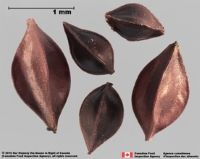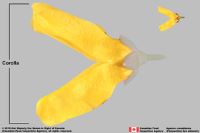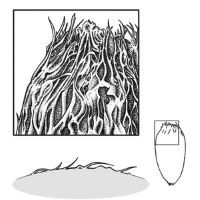Content is from Kirkbride et al. 2006Kirkbride et al. 2006:
Kirkbride JH, Jr, Gunn CR, and Dallwitz MJ. 2006. Family guide for fruits and seeds, vers. 1.0. Accessed September 2020-January 2022. URL: https://nt.ars-grin.gov/seedsfruits/keys/frsdfam/index.cfm ., without modification.
Updates are forthcoming.
Fruits: Pistil(s) 1; 1-pistillate. Fruit anthocarpanthocarp:
simple or compound and including some tissue of non-ovarian origin (accessory tissue) , or pericarpium; simple; acheneachene:
, or pericarpium; simple; acheneachene:
a dry, indehiscent, one-seeded fruit, with seed attached to pericarp at a single point, derived from a single, superior, simple or compound, one-loculed ovary (of authors, but not Spjut); compound; sorosus; without persistent central column; within accessory organ(s); within corollacorolla:
(of authors, but not Spjut); compound; sorosus; without persistent central column; within accessory organ(s); within corollacorolla:
the inner whorl(s) of the perianth; all the petals of a flower , or calyxcalyx:
, or calyxcalyx:
the outer whorl of the perianth; all the sepals of a flower , or perianthperianth:
, or perianthperianth:
collective term for calyx and corolla of a flower
 (all fleshy & depending on genus); accrescentaccrescent:
(all fleshy & depending on genus); accrescentaccrescent:
growing continuously
; persistent; soft calyxcalyx:
the outer whorl of the perianth; all the sepals of a flower ; 1-seeded; 1-seeded; less than 1 cm long; 0.1–0.3 cm long; with 1-carpellate; apexapex:
; 1-seeded; 1-seeded; less than 1 cm long; 0.1–0.3 cm long; with 1-carpellate; apexapex:
the point farthest from the point of attachment, or the "tip" of an organ not beaked; wall leatheryleathery:
not beaked; wall leatheryleathery:
texture—moderately thick, tough, and very pliable
; indehiscentindehiscent:
not opening on its own, as in a fruit
 . Epicarpepicarp:
. Epicarpepicarp:
outer layer of fruit wall or pericarp, if divided into layers; note here used synonymously with exocarp black (ish), or brown (all shades) (ish-red), or purple (ish); durable; without armature; without wing(s); without apicalapical:
black (ish), or brown (all shades) (ish-red), or purple (ish); durable; without armature; without wing(s); without apicalapical:
at or pertaining to the end of the seed or fruit distal from its point of attachment (i.e., base)
respiratory hole. Mesocarpmesocarp:
the middle layer of the pericarp, if divided into layers present; fibrousfibrous:
present; fibrousfibrous:
texture—long, flexible threads, thicker than hairs, that densely cover and obscure the surface to leatheryleathery:
to leatheryleathery:
texture—moderately thick, tough, and very pliable
, or thin; without lactiform cavity system. Endocarpendocarp:
the inner layer of the pericarp, if divided into layers present; not separating from exocarpexocarp:
present; not separating from exocarpexocarp:
outer layer of fruit wall or pericarp, if divided into layers; note here used synonymously with epicarp ; thin, or thick, or fleshy (to mucilaginousmucilaginous:
; thin, or thick, or fleshy (to mucilaginousmucilaginous:
resembling mucilage; moist and sticky
); not splitting into 1-seeded pyrenes; smooth; without wing; without operculumoperculum:
a dehiscent cap (or lid) of a seed or fruit that opens during germination or dehiscence ; without secretory cavities; without mechanism for seedling escape; without grooves; without longitudinallongitudinal:
; without secretory cavities; without mechanism for seedling escape; without grooves; without longitudinallongitudinal:
of or relating to length or the lengthwise dimension
ridges. Funiculusfuniculus:
(alt. funicle) stalk connecting the ovule (later seed) to the ovary (later fruit) placenta short; short without seed bearing hookswith hooks:
short; short without seed bearing hookswith hooks:
bristles or spines with curved or backwards pointing tips, or with secondary bristles along their length (retinacula); not persisting in fruit after seed shed.
(retinacula); not persisting in fruit after seed shed.
Seeds: Arilaril:
(broad sense) appendicular structure that wholly or partly envelops a seed and is produced from or a modification of the funicle, raphe, or outer integument; usually fleshy or pulpy, sometimes spongy or tufted-capillate, often brightly colored absent. Seed larger than minute; not bowl shaped; not nutlike; without winglike beakbeak:
absent. Seed larger than minute; not bowl shaped; not nutlike; without winglike beakbeak:
a usually firm, terminal appendage, sometimes tapered ; without caudatecaudate:
; without caudatecaudate:
tapering to a long, tail-like appendage appendage(s); at maturity with food reserves (in large seeds), or without food reserves (in small seeds; Ourouma); with endosperm; without canavanine. Sarcotestasarcotesta:
appendage(s); at maturity with food reserves (in large seeds), or without food reserves (in small seeds; Ourouma); with endosperm; without canavanine. Sarcotestasarcotesta:
pulpy or fleshy outer layer of the seed coat, simulates aril absent. Testatesta:
absent. Testatesta:
seed coat
 present (small seeds), or absent (large seeds); crushed (assumed); without embryo surrounded and capped by viscid tissue; without fleshy or leatheryleathery:
present (small seeds), or absent (large seeds); crushed (assumed); without embryo surrounded and capped by viscid tissue; without fleshy or leatheryleathery:
texture—moderately thick, tough, and very pliable
layer over hard layer; surface unsmooth; without crease or line separating cotyledons from hypocotyl-radicle; without notch along margin where cotyledons from hypocotyl-radicle tip approach each other; without glands; without bristles; without wings; without collar; without operculumoperculum:
a dehiscent cap (or lid) of a seed or fruit that opens during germination or dehiscence ; colored; monochrome; not becoming mucilaginousmucilaginous:
; colored; monochrome; not becoming mucilaginousmucilaginous:
resembling mucilage; moist and sticky
when wetted; surrounding embryo, or surrounding food reserve. Endosperm without fatty acid containing cyclopropene; without apicalapical:
at or pertaining to the end of the seed or fruit distal from its point of attachment (i.e., base)
lobes; without chlorophyll; without isodiametric faceted surface; without odor. Embryo differentiated from food reserve, or undifferentiated from food reserve; well developed; 1 per seed; completely filling testatesta:
seed coat
 (no food reserve), or nearly filling testatesta:
(no food reserve), or nearly filling testatesta:
seed coat
 (trace or scanty food reserve); at one end of seed not extending into a depression or cup; foliatefoliate:
(trace or scanty food reserve); at one end of seed not extending into a depression or cup; foliatefoliate:
appearing leaf-like
; with spatulatespatulate:
2D shape—like a spatula; rounded at the apex, with base long and tapered; (of embryo) embryo is straight and axile and centric with the cotyledons expanded to form the shape of a spatula or spoon; (of cotyledons) cotyledons expanded and wider than the stalk but not invested into the stalk cotyledons; straight; parallel to seed length; with cotyledons gradually connected to hypocotyl-radicle; without coleorhiza; without simmondsin; without stomata; not green; with 2 or more cotyledons. Cotyledons 2; well developed; 0.6–0.9 times length of embryo; somewhat to significantly wider than hypocotyl-radicle; not concealing hypocotyl-radicle; moderately thick, or thick; flat; smooth; with apicesapex:
cotyledons; straight; parallel to seed length; with cotyledons gradually connected to hypocotyl-radicle; without coleorhiza; without simmondsin; without stomata; not green; with 2 or more cotyledons. Cotyledons 2; well developed; 0.6–0.9 times length of embryo; somewhat to significantly wider than hypocotyl-radicle; not concealing hypocotyl-radicle; moderately thick, or thick; flat; smooth; with apicesapex:
the point farthest from the point of attachment, or the "tip" of an organ entire; with margins separate; basally entire; equal in size; not punctatepunctate:
entire; with margins separate; basally entire; equal in size; not punctatepunctate:
surface relief—dotted with pits or with translucent, sunken glands or with colored dots, similar to pitted dotted. Hypocotyl-radicle moderately developed; straight; not thickened.
dotted. Hypocotyl-radicle moderately developed; straight; not thickened.
Literature specific to this family: Berg, C.C., R.W.A.P. Akkermans, & E.C.H. van Heusden. 1990. Cecropiaceae: Coussapoa and Pourouma, with an introduction to the family. Fl. Neotrop. Monogr. 51:1–208.
General references: Cronquist, A. 1981. An integrated system of classification of flowering plants, 1,262 p. Columbia University Press, New York, Flora Neotropica. 1968–74. Nos. 1–14. Hafner Publishing Company, Darien & 1976-. Nos. 15-present. New York Botanical Garden, Bronx [monograph number], Gunn, C.R., J.H. Wiersema, C.A. Ritchie, & J.H. Kirkbride, Jr. 1992 & amendments. Families and genera of Spermatophytes recognized by the Agricultural Research Service. Techn. Bull. U.S.D.A. 1796:1–500, Mabberley, D.J. 1987. The plant-book, 706 p. Cambridge University Press, Cambridge, and Spjut, R.W. 1994. A systematic treatment of fruit types. Mem. New York Bot. Gard. 70:1–182.